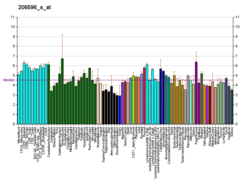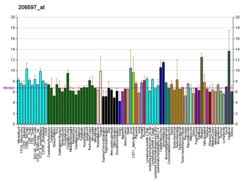NRL (gene)
| NRL | |||||||||||||||||||||||||||||||||||||||||||||||||||
|---|---|---|---|---|---|---|---|---|---|---|---|---|---|---|---|---|---|---|---|---|---|---|---|---|---|---|---|---|---|---|---|---|---|---|---|---|---|---|---|---|---|---|---|---|---|---|---|---|---|---|---|
| Identifiers | |||||||||||||||||||||||||||||||||||||||||||||||||||
| Aliases | NRL, D14S46E, NRL-MAF, RP27, neural retina leucine zipper | ||||||||||||||||||||||||||||||||||||||||||||||||||
| External IDs | OMIM: 162080; MGI: 102567; HomoloGene: 4501; GeneCards: NRL; OMA:NRL - orthologs | ||||||||||||||||||||||||||||||||||||||||||||||||||
| |||||||||||||||||||||||||||||||||||||||||||||||||||
| |||||||||||||||||||||||||||||||||||||||||||||||||||
| |||||||||||||||||||||||||||||||||||||||||||||||||||
| |||||||||||||||||||||||||||||||||||||||||||||||||||
| |||||||||||||||||||||||||||||||||||||||||||||||||||
| Wikidata | |||||||||||||||||||||||||||||||||||||||||||||||||||
| |||||||||||||||||||||||||||||||||||||||||||||||||||
Neural retina-specific leucine zipper protein is a protein that in humans is encoded by the NRL gene.[5][6][7]
Function
This gene encodes a basic motif-leucine zipper transcription factor of the Maf subfamily. The encoded protein is conserved among vertebrates and is a critical intrinsic regulator of photoreceptor cell development and function. Mutations in this gene have been associated with retinitis pigmentosa and degenerative diseases of the retina.[7]
See also
References
- ^ a b c ENSG00000285493 GRCh38: Ensembl release 89: ENSG00000129535, ENSG00000285493 – Ensembl, May 2017
- ^ a b c GRCm38: Ensembl release 89: ENSMUSG00000040632 – Ensembl, May 2017
- ^ "Human PubMed Reference:". National Center for Biotechnology Information, U.S. National Library of Medicine.
- ^ "Mouse PubMed Reference:". National Center for Biotechnology Information, U.S. National Library of Medicine.
- ^ Yang-Feng TL, Swaroop A (Oct 1992). "Neural retina-specific leucine zipper gene NRL (D14S46E) maps to human chromosome 14q11.1-q11.2" (PDF). Genomics. 14 (2): 491–2. doi:10.1016/S0888-7543(05)80248-4. hdl:2027.42/29820. PMID 1427865.
- ^ Bessant DA, Payne AM, Mitton KP, Wang QL, Swain PK, Plant C, Bird AC, Zack DJ, Swaroop A, Bhattacharya SS (Apr 1999). "A mutation in NRL is associated with autosomal dominant retinitis pigmentosa". Nature Genetics. 21 (4): 355–6. doi:10.1038/7678. PMID 10192380. S2CID 28621258.
- ^ a b "Entrez Gene: NRL neural retina leucine zipper".
Further reading
- Swaroop A, Xu JZ, Pawar H, Jackson A, Skolnick C, Agarwal N (Jan 1992). "A conserved retina-specific gene encodes a basic motif/leucine zipper domain". Proceedings of the National Academy of Sciences of the United States of America. 89 (1): 266–70. Bibcode:1992PNAS...89..266S. doi:10.1073/pnas.89.1.266. PMC 48217. PMID 1729696.
- Kumar R, Chen S, Scheurer D, Wang QL, Duh E, Sung CH, Rehemtulla A, Swaroop A, Adler R, Zack DJ (Nov 1996). "The bZIP transcription factor Nrl stimulates rhodopsin promoter activity in primary retinal cell cultures". The Journal of Biological Chemistry. 271 (47): 29612–8. doi:10.1074/jbc.271.47.29612. PMID 8939891.
- Farjo Q, Jackson A, Pieke-Dahl S, Scott K, Kimberling WJ, Sieving PA, Richards JE, Swaroop A (Oct 1997). "Human bZIP transcription factor gene NRL: structure, genomic sequence, and fine linkage mapping at 14q11.2 and negative mutation analysis in patients with retinal degeneration". Genomics. 45 (2): 395–401. doi:10.1006/geno.1997.4964. PMID 9344665.
- Chen S, Wang QL, Nie Z, Sun H, Lennon G, Copeland NG, Gilbert DJ, Jenkins NA, Zack DJ (Nov 1997). "Crx, a novel Otx-like paired-homeodomain protein, binds to and transactivates photoreceptor cell-specific genes". Neuron. 19 (5): 1017–30. doi:10.1016/S0896-6273(00)80394-3. PMID 9390516. S2CID 18485264.
- Mitton KP, Swain PK, Chen S, Xu S, Zack DJ, Swaroop A (Sep 2000). "The leucine zipper of NRL interacts with the CRX homeodomain. A possible mechanism of transcriptional synergy in rhodopsin regulation". The Journal of Biological Chemistry. 275 (38): 29794–9. doi:10.1074/jbc.M003658200. PMID 10887186.
- Swain PK, Hicks D, Mears AJ, Apel IJ, Smith JE, John SK, Hendrickson A, Milam AH, Swaroop A (Sep 2001). "Multiple phosphorylated isoforms of NRL are expressed in rod photoreceptors". The Journal of Biological Chemistry. 276 (39): 36824–30. doi:10.1074/jbc.M105855200. PMID 11477108.
- DeAngelis MM, Grimsby JL, Sandberg MA, Berson EL, Dryja TP (Mar 2002). "Novel mutations in the NRL gene and associated clinical findings in patients with dominant retinitis pigmentosa". Archives of Ophthalmology. 120 (3): 369–75. doi:10.1001/archopht.120.3.369. PMID 11879142.
- Wistow G, Bernstein SL, Wyatt MK, Ray S, Behal A, Touchman JW, Bouffard G, Smith D, Peterson K (Jun 2002). "Expressed sequence tag analysis of human retina for the NEIBank Project: retbindin, an abundant, novel retinal cDNA and alternative splicing of other retina-preferred gene transcripts". Molecular Vision. 8: 196–204. PMID 12107411.
- Acar C, Mears AJ, Yashar BM, Maheshwary AS, Andreasson S, Baldi A, Sieving PA, Iannaccone A, Musarella MA, Jacobson SG, Swaroop A (Jan 2003). "Mutation screening of patients with Leber Congenital Amaurosis or the enhanced S-Cone Syndrome reveals a lack of sequence variations in the NRL gene". Molecular Vision. 9: 14–7. PMID 12552256.
- Mitton KP, Swain PK, Khanna H, Dowd M, Apel IJ, Swaroop A (Feb 2003). "Interaction of retinal bZIP transcription factor NRL with Flt3-interacting zinc-finger protein Fiz1: possible role of Fiz1 as a transcriptional repressor". Human Molecular Genetics. 12 (4): 365–73. doi:10.1093/hmg/ddg035. PMID 12566383.
- Bessant DA, Holder GE, Fitzke FW, Payne AM, Bhattacharya SS, Bird AC (Jun 2003). "Phenotype of retinitis pigmentosa associated with the Ser50Thr mutation in the NRL gene". Archives of Ophthalmology. 121 (6): 793–802. doi:10.1001/archopht.121.6.793. PMID 12796249.
- Pittler SJ, Zhang Y, Chen S, Mears AJ, Zack DJ, Ren Z, Swain PK, Yao S, Swaroop A, White JB (May 2004). "Functional analysis of the rod photoreceptor cGMP phosphodiesterase alpha-subunit gene promoter: Nrl and Crx are required for full transcriptional activity". The Journal of Biological Chemistry. 279 (19): 19800–7. doi:10.1074/jbc.M401864200. PMID 15001570.
- Friedman JS, Khanna H, Swain PK, Denicola R, Cheng H, Mitton KP, Weber CH, Hicks D, Swaroop A (Nov 2004). "The minimal transactivation domain of the basic motif-leucine zipper transcription factor NRL interacts with TATA-binding protein". The Journal of Biological Chemistry. 279 (45): 47233–41. doi:10.1074/jbc.M408298200. PMID 15328344.
- Wright AF, Reddick AC, Schwartz SB, Ferguson JS, Aleman TS, Kellner U, Jurklies B, Schuster A, Zrenner E, Wissinger B, Lennon A, Shu X, Cideciyan AV, Stone EM, Jacobson SG, Swaroop A (Nov 2004). "Mutation analysis of NR2E3 and NRL genes in Enhanced S Cone Syndrome". Human Mutation. 24 (5): 439. doi:10.1002/humu.9285. PMID 15459973. S2CID 18561451.
- Nishiguchi KM, Friedman JS, Sandberg MA, Swaroop A, Berson EL, Dryja TP (Dec 2004). "Recessive NRL mutations in patients with clumped pigmentary retinal degeneration and relative preservation of blue cone function". Proceedings of the National Academy of Sciences of the United States of America. 101 (51): 17819–24. Bibcode:2004PNAS..10117819N. doi:10.1073/pnas.0408183101. PMC 535407. PMID 15591106.
- Khanna H, Akimoto M, Siffroi-Fernandez S, Friedman JS, Hicks D, Swaroop A (Sep 2006). "Retinoic acid regulates the expression of photoreceptor transcription factor NRL". The Journal of Biological Chemistry. 281 (37): 27327–34. doi:10.1074/jbc.M605500200. PMC 1592579. PMID 16854989.
External links
- GeneReviews/NCBI/NIH/UW entry on Retinitis Pigmentosa Overview
- NRL+protein,+human at the U.S. National Library of Medicine Medical Subject Headings (MeSH)
This article incorporates text from the United States National Library of Medicine, which is in the public domain.
- v
- t
- e
(1) Basic domains | |||||||||||||||||||||||||
|---|---|---|---|---|---|---|---|---|---|---|---|---|---|---|---|---|---|---|---|---|---|---|---|---|---|
| |||||||||||||||||||||||||
(2) Zinc finger DNA-binding domains | |||||||||||||||||||||||||||
|---|---|---|---|---|---|---|---|---|---|---|---|---|---|---|---|---|---|---|---|---|---|---|---|---|---|---|---|
| |||||||||||||||||||||||||||
(3) Helix-turn-helix domains | |||||||||||||||||||||
|---|---|---|---|---|---|---|---|---|---|---|---|---|---|---|---|---|---|---|---|---|---|
| |||||||||||||||||||||
(4) β-Scaffold factors with minor groove contacts | |||||||||||||||||||
|---|---|---|---|---|---|---|---|---|---|---|---|---|---|---|---|---|---|---|---|
| |||||||||||||||||||
(0) Other transcription factors | |||||||||
|---|---|---|---|---|---|---|---|---|---|
| |||||||||
 | This article on a gene on human chromosome 14 is a stub. You can help Wikipedia by expanding it. |
- v
- t
- e




















